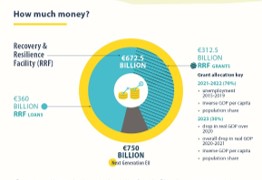 The German presidency of the EU Council and the European Parliament’s negotiators have reached a provisional agreement on the Recovery and Resilience Facility instrument.
The German presidency of the EU Council and the European Parliament’s negotiators have reached a provisional agreement on the Recovery and Resilience Facility instrument.
The facility is the centrepiece of the Next Generation EU recovery instrument which will support public investments and reforms in member states, helping them to address the economic and social impact of the COVID-19 pandemic, as well as the challenges posed by the green and digital transitions.
“The agreement with the European Parliament on the Recovery and Resilience Facility is the last key element of the EU’s historic recovery package. […] the facility sends a strong signal of Europe’s unity and determination to counter the COVID-19 crisis. It will give a strong boost to our economies and enable member states to shape a greener and more digital future for Europe’s citizens and businesses. This agreement is a crucial step to ensure that the much-needed money can start flowing next year,”Olaf Scholz, Germany’s Federal Minister for Finance and Vice Chancellor said.
With a financial envelope of EUR 672.5 billion in grants and loans the amount will be available to finance national measures designed to alleviate the economic and social consequences of the pandemic, from 1 February 2020 onwards. The funding will be available for three years and EU governments can request up to 13% pre-financing for their recovery and resilience plans. The payments of financial contributions to member states will be made by 31 December 2026.
The text, agreed on December 18, by negotiators from Budgets and Economic and Monetary Affairs committees with the Council, lays down the objectives, financing and rules for accessing the Recovery and Resilience Facility (RRF) funding. With the agreement on RRF, the last and biggest building block of the Next Generation EU has been put in place.
The negotiators agreed that national recovery and resilience plans would be eligible for financing if they focus on six policy areas of European relevance: the green transition including biodiversity, digital transformation, economic cohesion and competitiveness, social and territorial cohesion, institutional crisis-reaction and crisis preparedness, as well as policies for the next generation, children and youth, including education and skills. Finally, the RRF will only be made available to member states committed to respecting the rule of law and the European Union’s fundamental values.
Each plan will contribute at least 37% of its budget to climate and at least 20% to digital actions. According to the deal, the plans should have a lasting impact on EU countries in both social and economic terms and provide for comprehensive reform and a robust investment package. The measures to implement reforms and investments projects included in RRF plans cannot significantly harm environmental objectives.
Every two months, the Commission, which is responsible for monitoring the implementation of the RRF, may be invited by EP committees to discuss the state of the EU recovery and how the targets and milestones have been implemented by the member states. The EC will take EP opinions, including EP resolutions, into account. To facilitate this discussion, the Commission will transmit the member states’ plans to Parliament and Council at the same time.
Share on:



